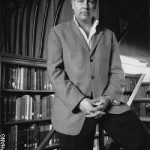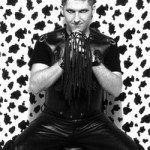Armed and Glamourous
"Fashion editors may look like Barbie," says Flare's Lisa Tant. "But we're GI Joe underneath." Meet one of the toughest
On the red carpet, tattoo-touting Bif Naked makes it past the assembly line of photographers, videographers, and entertainment reporters. The Canadian rocker, in a vintage black cocktail dress, Manolo Blahnik shoes, and Paul Frank boys’ underwear, heads toward the hostess. Lisa Tant stands in front of an archway that leads to Flare‘s 25th anniversary party at the Royal Ontario Museum (ROM) in Toronto. She is wearing a crimson, low-cut, floor-length gown by Canadian designer Lida Baday, and Birks diamond jewellery. She welcomes Naked with a cheek-to-cheek kiss and chitchat. As the new head of Canada’s No. 1 fashion magazine, Tant greets over 800 fashionistas and Canadian celebrities. This is a marquee night for Flare.
There was buzz even before media invitations were sent out. Everyone wanted to see what Tant, just seven months into her prestigious new job, was about. She appears to be a southern belle, but beneath the blond locks, bling-bling, and gown, is an ambitious editor who won’t let any obstacles stand in her way. The 40-year-old fashion veteran had already weathered a public bitch session in the National Post, when Scene columnist Shinan Govani compared her to Marcia Brady’s jealous younger sister, Jan, after the ROM event. But no less tough a critic than Rona Maynard,Chatelaine‘s former editor, has been her champion over the years. “She’s firm and clear,” says Maynard, “and doesn’t tolerate attitude or slipshod work.”
At Flare, Tant will have to put all these traits to work. With over 1.8 million readers, Flare sets the pace in the fashion industry. Tant’s challenge is to maintain the pole position. Twenty-five years ago, the magazine had no Canadian rivals, but now there are five major consumer fashion titles in the country, along with the recently arrived gaggle of shopping magazines. This level of competition tempts demanding advertisers to try to buy their way onto editorial pages.
Another pressure is the constant comparison of Tant to her “legendary” predecessor, Suzanne Boyd. Fashion is a personality-driven business. Great fashion editors create buzz, hot designers and photographers follow, readers flock, and advertising jumps – at least that’s the theory. “Tant has her work cut out for her in replacing Suzanne Boyd,” wrote The Globe and Mail‘s Rebecca Caldwell. “The native of Vancouver fills the stilettos of Suzanne Boyd,” CanWest News Service reported. “Trying to compare Suzanne to Lisa is like comparing a pineapple to a mango,” says Govani. “Lots of people are making the comparison.”
Since its launch in 1979 as a total transformation of the dated Miss Chatelaine, Flare has had its share of characters running the fashion show. Five editors, from trendsetters to trend-watchers, have evolved the publication from a fashion magazine for the working woman to Canada’s magazine for anyone who loves fashion. The most legendary editor of them all, Bonnie Fuller (now editorial director of American Media Inc., publisher of the tabloid Star and others), strutted her editorial legs at Flare from 1983 to 1989, covering ready-to-wear collections and injecting provocative headlines like “Incredible Hunks” and “Risqué Business.” Later on, in 1996, Boyd was appointed editor-in-chief, bringing with her even more glamour and sizzle. Last year, Boyd moved to New York to launch Suede, a title for “multi-culti urbanistas,” according to its website. But after only four issues and with the April 2005 issue at the printers, Boyd’s “cutting-edge fashion glossy” was put on hiatus because advertisers showed little interest in the magazine. During Boyd’s sometimes-controversial reign at Flare, she fought off stiff new competition from Fashion – formerly Toronto Life Fashion – which set out to capture urban readers, and a newly launched Canadian version of Elle. “The category is healthier and livelier than ever before,” says Jessica Johnson, the Globe‘s fashion editor.
At the ROM party, the dim lights give off a purplish hue. Flare publisher David Hamilton invites Tant to the podium. The surrounding crowd holds flutes of champagne to toast 25 fashionable years. “Everyone keeps asking how I’m going to change Flare,” says Tant. “It’s a great magazine – I don’t want to change it.” In public, Tant has steadily reiterated some version of the mantra – “If it ain’t broke, don’t fix it” – yet since her appointment she’s made six staff changes. Tant calls it “cleaning house”; others, like Govani, call it a “mass exodus.” Tant also renovated the décor department and launched two new columns. Globe columnist Lynn Crosbie’s “Love Life” offering, says Tant, “replaces another column, also called ‘Love Life,’ that was a bit junior, about dating and boys, and I thought it was too young.” The other new column, “Male Room,” features various male voices, including CBC Radio film reviewer Don Irvine.
In design, Tant and longtime art director Tanya Watt freshened Flare‘s pages by playing with white space, new colours, and new photographers. Her instinct for what readers want visually paid instant dividends. She scored Flare‘s biggest-selling cover of 2004 in August by featuring the 30-something-popstar-mom Sarah McLachlan, who was dressed comfortably in a pair of blue jeans, crimson top, and silver Betsey Johnson heels. The photographer captured her cascading loose curls in mid-flow, and captivating smile in mid-laugh. Originally, the cover was slated to feature a serious looking McLachlan in an uncomfortable gown. When Tant saw the more relaxed photo, she went with it immediately. Hamilton credits the success of the issue to Tant’s choice of celebrity and photo, as well as a special 16-page beauty pullout.
Shortly after the ROM event, Tant spoke at a magazine luncheon about her experiences since arriving at the helm. Masthead editor Bill Shields, who covered the luncheon, was amazed by her frankness. She spoke of conflicts that had arisen because some staffers weren’t welcoming to her and her changes. “From an ad point of view, to walk into the No. 1 book in the category and announce you are going to change every single page is gutsy,” says Shields. “I was impressed by how badly she wanted the job.”
So badly that when she heard Boyd was leaving for New York, Tant hired an art director to design her vision of the magazine, inspired by British Elle and BritishVogue, to impress Hamilton. She faced resistance, partly because of her association with the more-homespun Chatelaine. Maynard appointed Tant beauty editor seven years ago, then to beauty and fashion editor, and before long, started encouraging her into management. Eventually Tant was elevated to executive editor of the services department, the position she held prior to her arrival at the top of the Flare masthead. In the end, she won over publisher Hamilton with her plan: expand the franchise, deepen readership, place less emphasis on celebrity, and make it more popular so that anyone interested in style can read the magazine. Tant is up against formidable competitors, but she loves it. “We may look like Barbie,” she says, “but we’re GI Joe underneath.”
And Tant will have to deploy her forces, because her competition isn’t sleeping. Last May, Fashion modeled its first redesigned issue. The new look positions it as a national publication with city editions in Toronto, Montreal, and Vancouver. Of the structure of the magazine, editor-in-chief Ceri Marsh says, “The new architecture goes from international to national to local.” Her magazine is aimed at Canada’s urban fashionistas, the kind of consumers who want to know what women in cities like Paris and Milan are wearing. Marsh also expanded the beauty section. An expert on urban decorum, Marsh cowrote two bestselling books on the subject, and has been a guest on Oprah. Marsh encourages members of her team to think of themselves as readers. “Ceri is the reader,” says Giorgina Bigioni, Fashion’s publisher. “She has the same interests that readers have about looking and feeling their best.”
Elle Canada, the 33rd international edition of the Elle brand, is the most eclectic magazine in the category. In addition to beauty and fashion coverage, it offers its readers a living section with décor, gourmet, and travel features. The magazine tries to cover women’s issues in Canada and abroad, with stories such as October 2004’s piece on the Mixtec women of Pinotepa de Don Luis, who fear losing their art of weaving with a rare purple dye called purpura. The Globe‘s Johnson thinks the magazine gives great relationship advice, too. “It’s like talking to a sister or an old friend through the pages.”
Women spend thousands on fashion magazines and advertisers spend millions on advertising space. WhenElle Canada launched, some wondered if it would cut into the advertising revenue pie that Flare and Fashionshare. Instead, the pie expanded. According to LNA FasTrack, in 2001 (when Elle Canada launched) the combined advertising revenue of Flare, Fashion, and Elle Canada was at least $36 million. In 2004, that number grew to at least $52 million.
Quarterly magazines FQ and The Look, formerly Elm Street the Look, focus on fashion as a part of culture.FQ is a canvas for Canadian icon Jeanne Beker’s view from inside the fashion world. Beker, who knows designers like Karl Lagerfeld personally, has access to insider parties, couture fashions, and an international pool of photographers and writers, including the Village Voice‘s Michael Musto. FQ doesn’t tell readers what boots to wear with what skirt – the magazine avoids the term “must-have” – but readers do want Beker’s authority, so the Global Spin department spotlights top style picks from around the world, listing best spas to best restaurants.
The Look appeals to a broad range of readers – not necessarily just readers of fashion magazines, explains editor-in-chief David Livingstone, but those interested in looking for a less conventional approach. Literary writers Derek McCormack and Sheila Heti, for example, contributed to the winter 2005 issue. “It’s a thinking woman’s fashion magazine,” says Johnson, who reads it because she’s always interested in what Livingstone, in particular, has to say about fashion. “David knows more about fashion than anyone,” she enthuses.
Livingstone clearly wants to give The Look a broader perspective than simple service journalism. Even The Fashion Look, a front-of-book department, describes the latest fashion trends thoughtfully rather than covetously. Livingstone notes the emphasis on where to get things in today’s fashion titles, but scoffs, “How uninteresting is that? That’s what store windows are for.”
But many readers do value the service aspect. “If you can tell me where to find the perfect white blouse or the perfect pair of jeans, then you have just saved me three hours and that is incredibly valuable to me,” says Elizabeth Renzetti, the U.K. correspondent for the Globe and a social trends feature writer for Flare. She thinks to disparage service is shortsighted. “All consumer magazines should offer service, or else people will think the magazine is a waste of time,” she says. Though, she adds, “they can’t be just service, like shopping magazines.”
When a new editor takes over, the first question is usually whether there will be sweeping changes or a desire to maintain the status quo. The next question is whether readers will be offered hard-hitting stories alongside the beauty tips and fashion news. “There are many ways to write for women’s magazines,” says Renzetti, “ranging from research-heavy, deeply reported pieces where you quote a lot of experts, to the kind of anecdotal and chatty pieces that you find in a basement-level magazine like Cosmopolitan.”
Tant does run serious pieces, like “I Overcame This,” about a young breast cancer survivor, which are relevant to readers. But generally, she’s pragmatic and sticks to advice, like how to achieve the runway look. It’s service all the way. “I don’t care what the insiders think, I care what the readers think,” she says. “If you don’t have your readers, you’re screwed.” Flare doesn’t “look down on readers,” says beauty editor Juliette Lie. “‘Go get Botox because it’s in, and go do it now because it’s good’ – we don’t want to do that.” Instead the content says this: here are your options, both pro and con; you decide if it’s right for you.
Interaction with readers is an essential strategy at Flare, and Tant inherited the Flare Advisory Council. For two years, this monthly web panel of several hundred readers has been a “valuable” tool in measuring the magazine’s successes and faux pas. The council gives feedback on covers and new elements in the magazine, rates which features generate the most enjoyment, and comments on how Flare compares to other publications. For the most part, Tant’s readers want short and entertaining pieces, and that’s what she intends to offer.
Tant’s approach is supported in Fashion: A Canadian Perspective, a collection of essays. Deborah Fulsang, the Globe‘s fashion editor (currently on maternity leave), explains how the advent of fashion television in the mid-1980s affected fashion journalism: “It has fostered a form of ‘lite’-journalism reporting, where information is crafted into tight sound bites, bullet-form lists, and snappy, provocative headlines.”
In the early 1980s, before the advent of fashion television, both Flare and Toronto Life Fashion featured lengthy articles of about 2,500 words or more. Fulsang argues that the emergence of fashion television has further encouraged “more thought-provoking fashion writing.” Today, in the pages of Flare, that’s not the case. The features run at about 1,000 words, and Tant takes issue when people think that a smart magazine has to have long articles. “I want us to be Flare,” she snaps tartly, “not Time.”
Back at the party, my attempts to interview a certain statuesque ex-editor have been futile. Encircled by people, Boyd is standing steps away from the portrait Bryan Adams snapped of her for the 25th anniversary book. The DJ starts playing “California Love” by the late rapper Tupac Shakur. Shimmering in a Valentino cocktail dress, Boyd starts bobbing. When this rap number put Tupac at the top of the charts in 1996, Boyd had just been appointed Flare‘s editor-in-chief. She was a striking presence; she pushed boundaries and brought a lot of attention to Flare.
Not all of the attention has been positive, though. For the February 2003 issue of Flare, Boyd decided to put a picture of a car on the cover to announce a giveaway. A month later, Flare‘s auto fashion cover becameMasthead‘s cover story on crossing the line between editorial and advertising. In a hard-hitting column, Shields criticized Boyd’s decision. He wrote, “Not only did she allow Mazda to buy its way onto her cover, she even managed to get the logo in there, and in the most conspicuous of regions – right between the model’s legs. The visual pun is almost too blatant to express – magazine spreads legs for advertiser.” Shield’s wrote that Boyd justified her decision to run with the photo by explaining it was one of the few in which the model was smiling and relaxed. At the time, other editors, like former Fashion editor-in-chief Leanne Delap and Elle Canada’s Silvan, told Masthead they were uncomfortable with Boyd’s decision.
Fast forward a few months to June 2003. Speculation is rife that Delap resigned her position as editor of Fashion because her publisher, Bigioni, pressured her to run pieces advertisers might consider a little friendlier. In a Globe article, Bigioni denies the accusation, insisting that Delap left because she had been at the helm for three and a half years. Delap still won’t comment on the details of her sudden departure, except to say that the market had become more competitive with the arrival of Elle Canada, and with this new level of intensity came increased demands from advertisers. “My attempt to keep church and state separate was my own line, and it comes from the Globe‘s policy,” says Delap. She worked there for three years as a fashion reporter and then editor before taking the editor’s job at Fashion. “Over time,” she continues, designers “start sending you handbags. It gets harder and harder to resist.”
But the connection between advertising and editorial is always made to sound “more sinister and immoral than it really is,” says The Look’s Livingstone. In fact, he says, the connection is rational and obvious because advertisers indicate what’s available in the marketplace. Fashion’s Marsh agrees. “You’re a journalist and you cover your beat,” she says. Editors need to report what’s new and trendy, and who the people and personalities behind the products are, regardless of advertising.
Hamilton, Tant’s publisher, thinks it’s inappropriate for advertisers to buy their way onto editorial pages, but admits that all things being equal, he’ll suggest that Flare‘s editorial team feature an advertiser’s as opposed to a non-advertiser’s products. He says they don’t have to listen to his suggestions.
The swarm around Boyd and her $500,000 Lorraine Schwartz gems has dispersed, and finally, she looks available. I dart over. “Suzanne,” I say. “Excuse me, Suzanne.” I’m looking up at her. My black press pass is in plain view against the backdrop of my gold top. Standing in a pair of green Gucci, mink-trimmed satin heels, Boyd looks down at me. “My name is Anna-Christina Di Liberto. I’m writing for the Ryerson Review of Journalism. Could I….”
She turns her back to me and starts talking to Noel, a curly haired man whose head only reaches her shoulders. She tells Noel to find out what I want. Noel becomes the middleman, and asks what I want. This time I finish my sentence. “Could I ask Suzanne a couple of questions?”
“Hold on,” Noel says. Noel turns around to face Boyd. He relays my request. Finally, Boyd talks to me herself. The last question I pose to her is, “What advice would you give to Lisa Tant?”
Boyd answers in her sultry, deep voice: “I think she can figure things out on her own.”











































